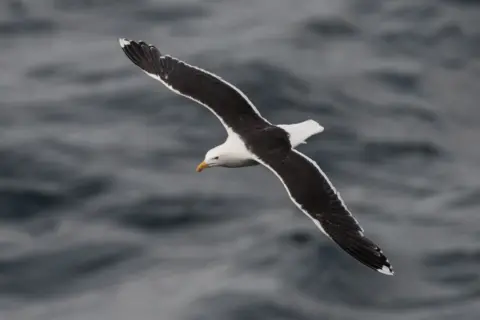
 Getty Images
Getty Images
Arctic terns nest on British shores before flying to the Antarctic for winter
Five seabird species have been added to the UK red list of birds at most need of conservation, joining others such as the puffin.
The new entries include the Arctic tern, known for its incredible migration, the giant skua, or pirate of the sea, and two types of gull.
The UK is known for its colonies of seabirds nesting in huge numbers on cliffs - but populations are plummeting amid a host of pressures, from climate change to a lack of food.
The Royal Society for the Protection of Birds (RSPB) is calling for urgent government action to address "this dire situation".

 Getty Images
Getty Images
The UK is known for its populations of breeding seabirds, such as these northern gannets
"As an island nation, it is perhaps not surprising that we are globally important for seabird populations," RSPB global conservation director Katie-jo Luxton said.
"But what has really shocked us is the sheer number of our seabird species now on the red list."
Of the 26 seabirds that breed on the UK's coastlines and islands, 10 are now on the list.
The five new entries are:

 Getty Images
Getty Images
The great black-backed gull is the largest member of the gull family

 Getty Images
Getty Images
The great skua, sometimes known by the name bonxie in Britain, feeds on fish caught from the sea or taken from other birds

 Getty Images
Getty Images
Arctic tern in flight
Five other seabirds were already on the list - the puffin, kittiwake, herring gull, roseate tern and arctic skua.
Seabirds are in trouble because of climate change, unsustainable fishing practices, offshore renewable-energy development and habitat loss.
According to last year’s Seabirds Count, the biggest UK census for 20 years, 62% of UK seabird species are in decline – kittiwakes and common gulls are down nearly 50% and puffin numbers have fallen by a quarter.
“We should be really concerned about this, because the UK is really important for breeding seabirds," British Trust for Ornithology surveys head Dawn Balmer, head of surveys said.
RSPB marine policy officer Jean Duggan called it a "wake-up call".
"It’s not just about safeguarding these species for ourselves at home, it's also safeguarding global populations and preventing future extinctions,” she said.

 Getty Images
Getty Images
The UK is known for its seabirds, such as the puffin
There is good news for some of the seabirds that breed in the UK, with the shag moving from the red list to the amber and the black guillemot from the amber to the green.
But of the 245 birds regularly seen in the UK, including farmland, woodland and garden birds as well as seabirds, 73 (30%) are now on the red list.

 Movie
Movie 3 months ago
39
3 months ago
39 






![Presidents Day Weekend Car Sales [2021 Edition] Presidents Day Weekend Car Sales [2021 Edition]](https://www.findthebestcarprice.com/wp-content/uploads/Presidents-Day-Weekend-car-sales.jpg)



 English (United States)
English (United States)